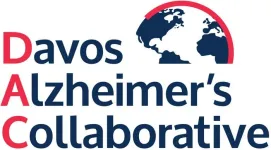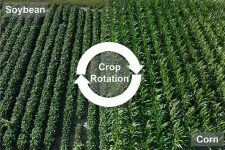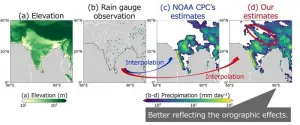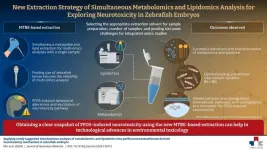(Press-News.org) WASHINGTON — Researchers have developed a reliable and reproducible way to fabricate tapered polymer optical fibers that can be used to deliver light to the brain. These fibers could be used in animal studies to help scientists better understand treatments and interventions for various neurological conditions.
The tapered fibers are optimized for neuroscience research techniques, such as optogenetic experiments and fiber photometry, which rely on the interaction between genetically modified neurons and visible light delivered to and/or collected from the brain.
“Unlike standard optical fibers, which are cylindrical, the tapered fibers we developed have a conical shape, which allows them to penetrate the tissue with more ease and to deliver light to larger volumes of the brain,” said research team member Marcello Meneghetti from the Neural Devices and Gas Photonics group at the Technical University of Denmark. “Furthermore, making the fibers from soft, flexible polymers rather than stiff, sometimes brittle glass can reduce tissue inflammation over long periods of implantation.”
In the Optica Publishing Group journal Optics Letters, the researchers describe how they designed and fabricated tapered polymer optical fibers for efficient light delivery in the brain. The tapers were crafted from optical fibers just 50 microns in diameter — approximately the width of a human hair.
“Our polymer tapers make it possible to modulate the behavior of and record activity from more neurons, thus allowing the study of larger brain circuits,” said Meneghetti. “This could produce deeper insights into how complex brain circuits function, how behaviors are controlled and how brain diseases or disorders might disrupt these circuits.”
Illuminating more neurons
Cylindrical optical fibers such as the ones used in telecommunications are very good at confining light, which means that light can enter the fiber and be delivered to the output with very little loss along the way. However, conical fibers allow light to leak from the sides of the fiber along the length of the tapered tip, which increases the volume that can be illuminated.
After observing the growing use of glass fiber tapers for efficient modulation and recording of neuronal activity, the researchers set out to adapt this technology to polymer optical fibers. The work is funded by the Move2Treat grant, a research initiative funded under the European Innovation Council Pathfinder Open program to develop innovative solutions for treating neurological disorders.
“Long-term inflammation and implant breakage are persistent challenges in silica- or silicon-based neurophotonics,” said Meneghetti. “The mechanical mismatch between implants and brain tissue triggers inflammation, and the brittleness of these materials leads to fractures at sub-millimeter scales. Using polymer-based fibers, which are over 10 times less stiff, significantly mitigates these issues.”
Optimizing fabrication
To create the new tapered polymer fibers, the researchers used numerical models to determine the ideal taper geometry and developed a chemical etching process to fabricate them. They tested various solvents and protocols to achieve the desired tips, verifying the geometry and ensuring surface integrity with scanning electron microscopy.
The researchers then used their tapered polymer fibers to illuminate slices of agarose gel, which is known to have optical properties similar to brain tissue. Compared to standard optical fibers with the same diameter and constituent material, the lateral spread of light was more than doubled using the tapered optical fibers.
“We hope that this research will lead to further advancements in the field while also paving the way for innovative devices,” said Meneghetti. “It might also be a useful stepping stone for anyone interested in these tapers for other applications such as sensing.”
Next, the researchers plan to demonstrate the new tapered fibers in an animal model to evaluate the functionality and ability to reduce inflammation. In the future, combining the new fabrication process with post-processing techniques such as nanofabrication could lead to fully integrated devices that not only deliver and collect light but also detect electrical signals and sense temperature or chemical changes in the brain. This could provide an even more comprehensive understanding of brain activity in both healthy and diseased states.
This research was funded by the European Union. Views and opinions expressed are those of the author(s) only and do not necessarily reflect those of the European Union. Neither the European Union nor the granting authority can be held responsible for them.
About Optica Publishing Group
Optica Publishing Group is a division of the society, Optica, Advancing Optics and Photonics Worldwide. It publishes the largest collection of peer-reviewed and most-cited content in optics and photonics, including 18 prestigious journals, the society’s flagship member magazine, and papers and videos from more than 835 conferences. With over 400,000 journal articles, conference papers and videos to search, discover and access, our publications portfolio represents the full range of research in the field from around the globe.
About Optics Letters
Optics Letters has been publishing high-impact research in the field of photonics for over 45 years and offers rapid dissemination of new results in all areas of optical science with short, original, peer-reviewed communications. Optics Letters accepts papers that are noteworthy to a substantial part of the optics community. Published by Optica Publishing Group and led by Editor-in-Chief Miguel Alonso, Institut Fresnel, École Centrale de Marseille and Aix-Marseille Université, France, University of Rochester, USA. For more information, visit Optics Letters.
Media Contact
mediarelations@optica.org
END
Tapered polymer fibers enhance light delivery for neuroscience research
New fiber implants pave the way to better light-based studies in the brain, advancing techniques like optogenetics
2025-01-15
ELSE PRESS RELEASES FROM THIS DATE:
Syracuse University’s Fran Brown named Paul “Bear” Bryant Newcomer Coach of the Year Award recipient
2025-01-15
HOUSTON, January 15, 2025 — The American Heart Association has named Syracuse University’s Fran Brown as the recipient of the 2024 Paul “Bear” Bryant Newcomer Coach of the Year Award. This award celebrates the achievements of an individual who has not had any previous head coaching experience at the NCAA Division I football sub-division (FBS) level.
Coach Brown will be recognized with the honor during the 2025 Bear Bryant Awards on January 22.
After being named Syracuse’s 31st head coach on November 28, 2023, Brown immediately instilled a culture of ...
DARPA-ABC program supports Wyss Institute-led collaboration toward deeper understanding of anesthesia and safe drugs enabling anesthesia without the need for extensive monitoring
2025-01-15
By Benjamin Boettner
(BOSTON) — Currently, no anesthetic compound or cocktail can be used safely outside of a hospital facility. This is because current drugs impair the brain and central nervous system’s ability to regulate a number of vital processes, including respiration, body temperature, and heart rate in addition to creating a state of unconsciousness or sedation, making the strict monitoring of patients with the help of sophisticated instruments and highly-trained clinical personnel an absolute necessity. To reduce trauma associated with injuries and improve combat casualty outcomes, under a new DARPA-ABC contract ...
The Offshore Wind Innovation Hub 2025 call for innovators opens today
2025-01-15
The Offshore Wind Innovation Hub today announced the opening of its 2025 application process, designed to identify and support entrepreneurial and innovative companies that will help unleash the potential of the dynamic emerging offshore wind industry.
Winners take on a six-month mentoring and business development program residency designed to prepare them for strategic partnerships with major offshore wind developers and to be part of the larger offshore wind value chain. The program aims to enable innovators to overcome barriers ...
Aligning Science Across Parkinson’s (ASAP) launches a new funding opportunity to join the Collaborative Research Network
2025-01-15
The Aligning Science Across Parkinson’s (ASAP) initiative opened applications for members of the research community to apply to join the Collaborative Research Network (CRN) 2025 Scientific Track. The new Scientific Track grants will support collaborative research teams focused on dissecting the mechanisms that contribute to Parkinson’s disease (PD) heterogeneity across one of six focus areas listed below, offering funding of up to $3 million per year over three years.
Examining PD in the context of aging
Understanding how co-pathologies can influence PD pathogenesis and progression
Dissecting ...
State-of-the-art fusion simulation leads three scientists to the 2024 Kaul Foundation Prize
2025-01-15
Three scientists were awarded the 2024 Kaul Foundation Prize for Excellence in Plasma Physics Research and Technology Development based on their decades of groundbreaking research about how plasma behaves in fusion reactors.
Choongseok (CS) Chang, Seung-Hoe Ku and Robert Hager of the U.S. Department of Energy’s (DOE) Princeton Plasma Physics Laboratory (PPPL) were recognized “for experimentally validated simulations of turbulence-broadened divertor heat flux widths using the X-Point Included Gyrokinetic Code (XGC),” following decades of research developing comprehensive simulations to model the fusion plasma edge.
Recently, ...
Davos Alzheimer's Collaborative launches innovative brain health navigator program for intuitive coordination between patients and providers
2025-01-15
The Davos Alzheimer’s Collaborative (DAC), a pioneering worldwide initiative seeking to cure Alzheimer’s disease and improve brain health, today announced the launch of its Brain Health Navigator program. The initiative led by the DAC Healthcare System Preparedness (DAC-SP) team will provide resources for patients and providers at six sites across the U.S.
Despite Alzheimer’s status as a growing worldwide epidemic, pathways for accurate diagnosis and evidence based interventions including new therapies are either underdeveloped or non-existent. ...
Media registration now open: ATS 2025 in San Francisco
2025-01-15
New York, NY – Jan. 15, 2025 –We are excited to welcome you to San Francisco for the ATS 2025 International Conference! Journalists will have access to leaders, as well as emerging scientists and clinicians, who are at the forefront of medical breakthroughs and clinical innovation in pulmonary, critical care and sleep medicine.
Join us beginning Sunday, May 18* through Wednesday, May 21. Register now and check out our Program at a Glance.
As always, you are welcome to contact the ATS communications and marketing director about scientific sessions and expert interviews whether you are joining us in person or from your (home) office. Registered ...
New study shows that corn-soybean crop rotation benefits are extremely sensitive to climate
2025-01-15
MINNEAPOLIS / ST. PAUL (01/15/2024) — A study by researchers at the University of Minnesota Twin Cities offers new insights into how alternating corn and soybean crops can help increase crop yield in a changing climate.
The research is published in the peer-reviewed scientific journal Global Change Biology.
Rising temperatures and weather extremes are threatening global food security, making it crucial to understand how sustainable practices like crop rotation can help improve agricultural yields and resilience.
The study found that the benefits to corn-soybean rotation, compared to continuous corn year after year, are extremely sensitive to ...
From drops to data: Advancing global precipitation estimates with the LETKF algorithm
2025-01-15
With the increase in climate change, global precipitation estimates have become a necessity for predicting water-related disasters like floods and droughts, as well as for managing water resources. The most accurate data that can be used for these predictions are ground rain gauge observations, but it is often challenging due to limited locations and sparse rain gauge data. To solve this problem, Assistant Professor Yuka Muto from the Center for Environmental Remote Sensing, Japan, and Professor Shunji Kotsuki of the Institute for Advanced Academic Research, Center for Environmental Remote Sensing, ...
SeoulTech researchers propose a novel method to shed light on PFOS-induced neurotoxicity
2025-01-15
The term “omics” refers to the study of entirety of molecular mechanisms that happen inside an organism. With the advent of omics technologies like transcriptomics, proteomics, metabolomics, and lipidomics, our understanding of molecular pathways of toxic environmental pollutants has deepened. But most environmental toxicology studies are still dependent on a single-omics analyses, leading to gaps in our understanding of integrated toxicity pathways of pollutants. Researchers from all over the world have ...
LAST 30 PRESS RELEASES:
Sports injuries sustained during your period might be more severe
World's first successful 2 Tbit/s free-space optical communication using small optical terminals mountable on satellites and HAPS
Can intimate relationships affect your heart? New study says ‘yes’
Scalable and healable gradient textiles for multi‑scenario radiative cooling via bicomponent blow spinning
Research shows informed traders never let a good climate crisis go to waste
Intelligent XGBoost framework enhances asphalt pavement skid resistance assessment
Dual-function biomaterials for postoperative osteosarcoma: Tumor suppression and bone regeneration
New framework reveals where transport emissions concentrate in Singapore
NTP-enhanced lattice oxygen activation in Ce-Co catalysts for low-temperature soot combustion
Synergistic interface engineering in Cu-Zn-Ce catalysts for efficient CO2 hydrogenation to methanol
COVID-19 leaves a lasting mark on the human brain
Scientists use ultrasound to soften and treat cancer tumors without damaging healthy tissue
Community swimming program for Black youth boosts skills, sense of belonging, study finds
Specific depressive symptoms in midlife linked to increased dementia risk
An ‘illuminating’ design sheds light on cholesterol
Who is more likely to get long COVID?
Study showcases resilience and rapid growth of “living rocks”
Naval Research Lab diver earns Office of Naval Research 2025 Sailor of the Year
New Mayo-led study establishes practical definition for rapidly progressive dementia
Fossil fuel industry’s “climate false solutions” reinforce its power and aggravate environmental injustice
Researchers reveal bias in a widely used measure of algorithm performance
Alcohol causes cancer. A study from IOCB Prague confirms damage to DNA and shows how cells defend against it
Hidden viruses in wastewater treatment may shape public health risks, study finds
Unlock the power of nature: how biomass can transform climate mitigation
Biochar reshapes hidden soil microbes that capture carbon dioxide in farmland
Reducing saturated fat intake shows mortality benefit, but only in high-risk individuals
Manta rays create mobile ecosystems, study finds
Study: Mixed results in using lipoic acid to treat progressive multiple sclerosis
Norbert Holtkamp appointed director of Fermi National Accelerator Laboratory
New agentic AI platform accelerates advanced optics design
[Press-News.org] Tapered polymer fibers enhance light delivery for neuroscience researchNew fiber implants pave the way to better light-based studies in the brain, advancing techniques like optogenetics





